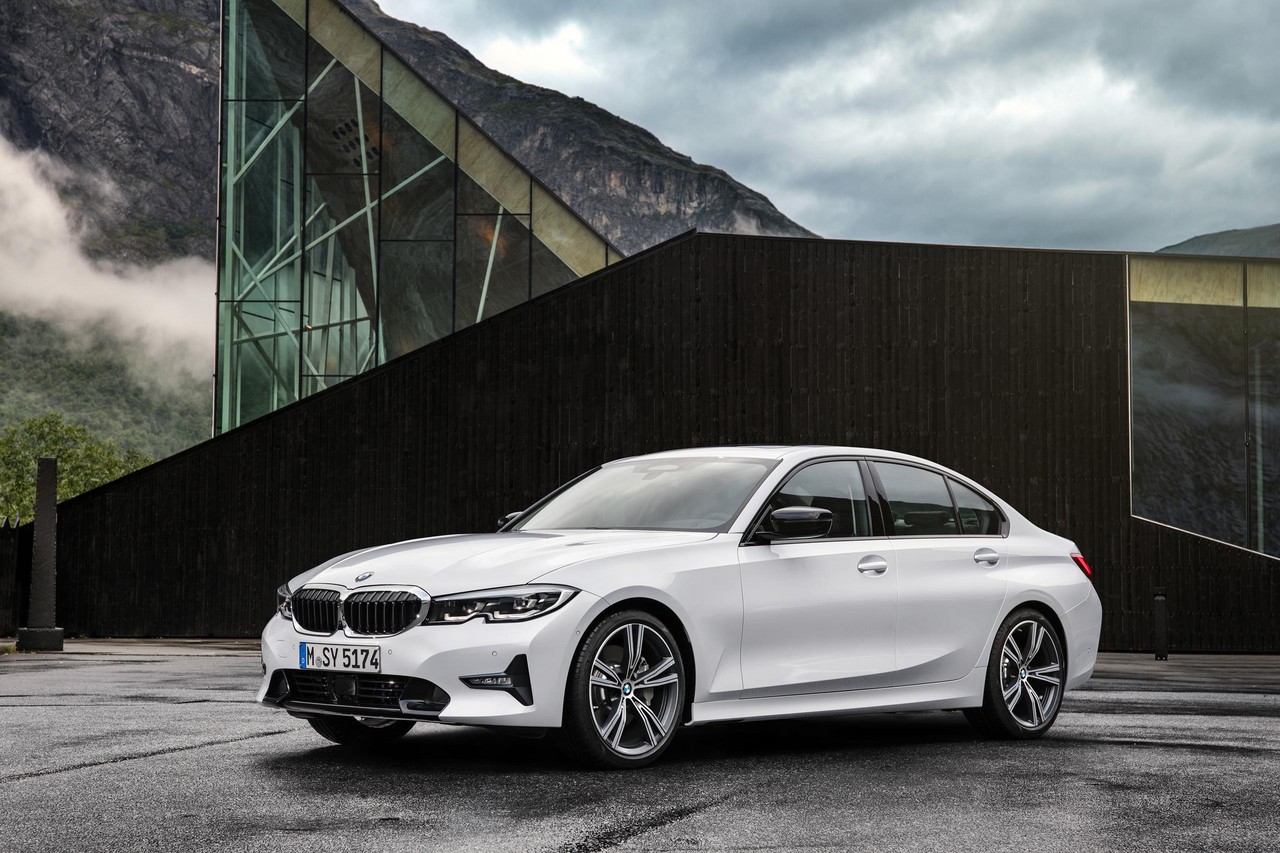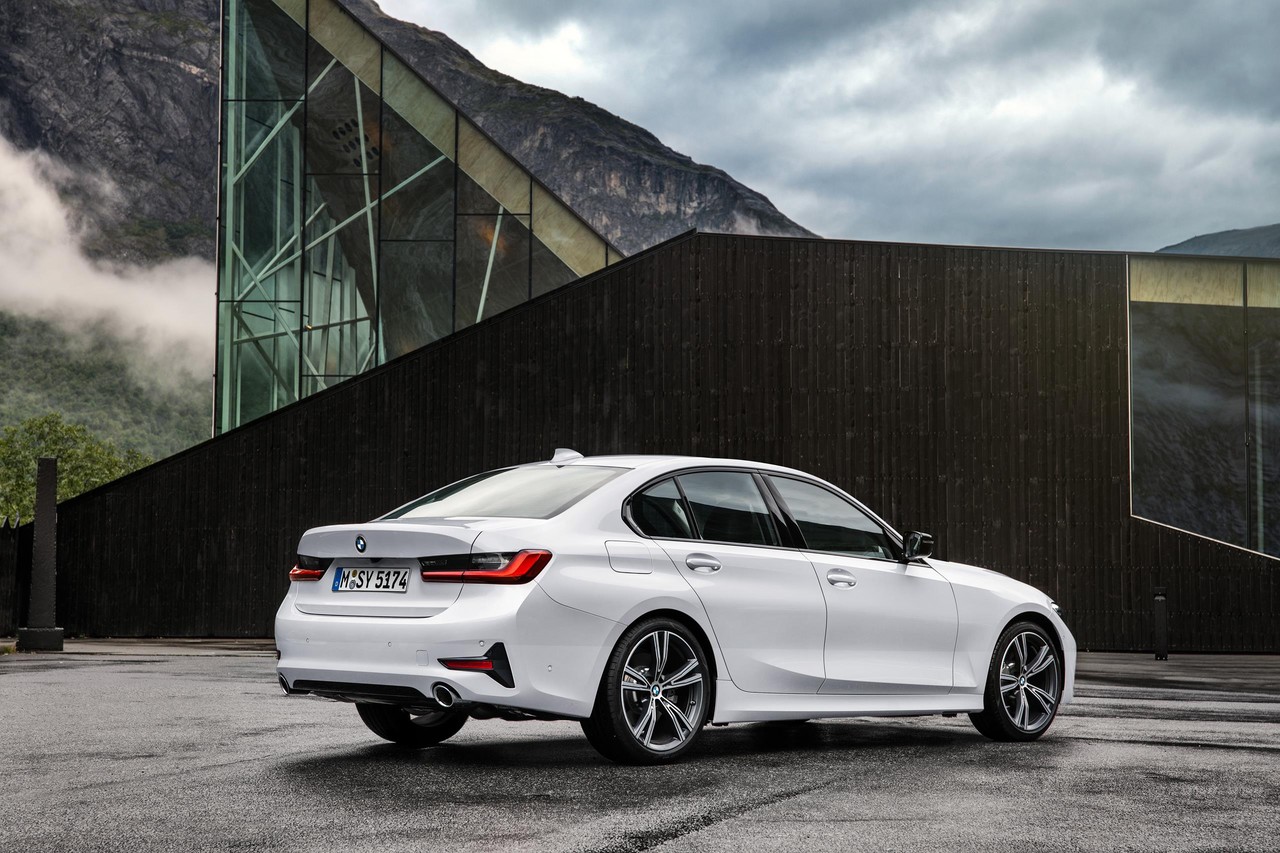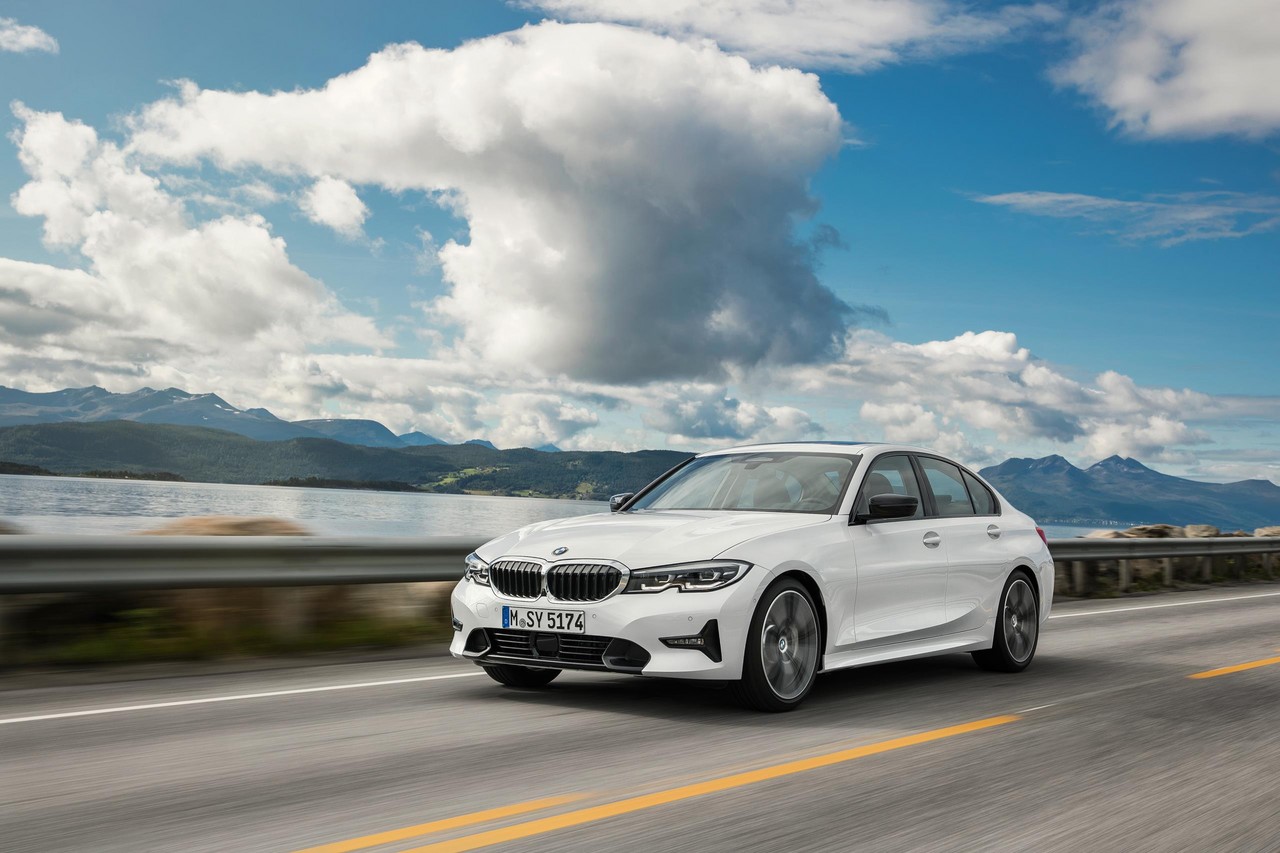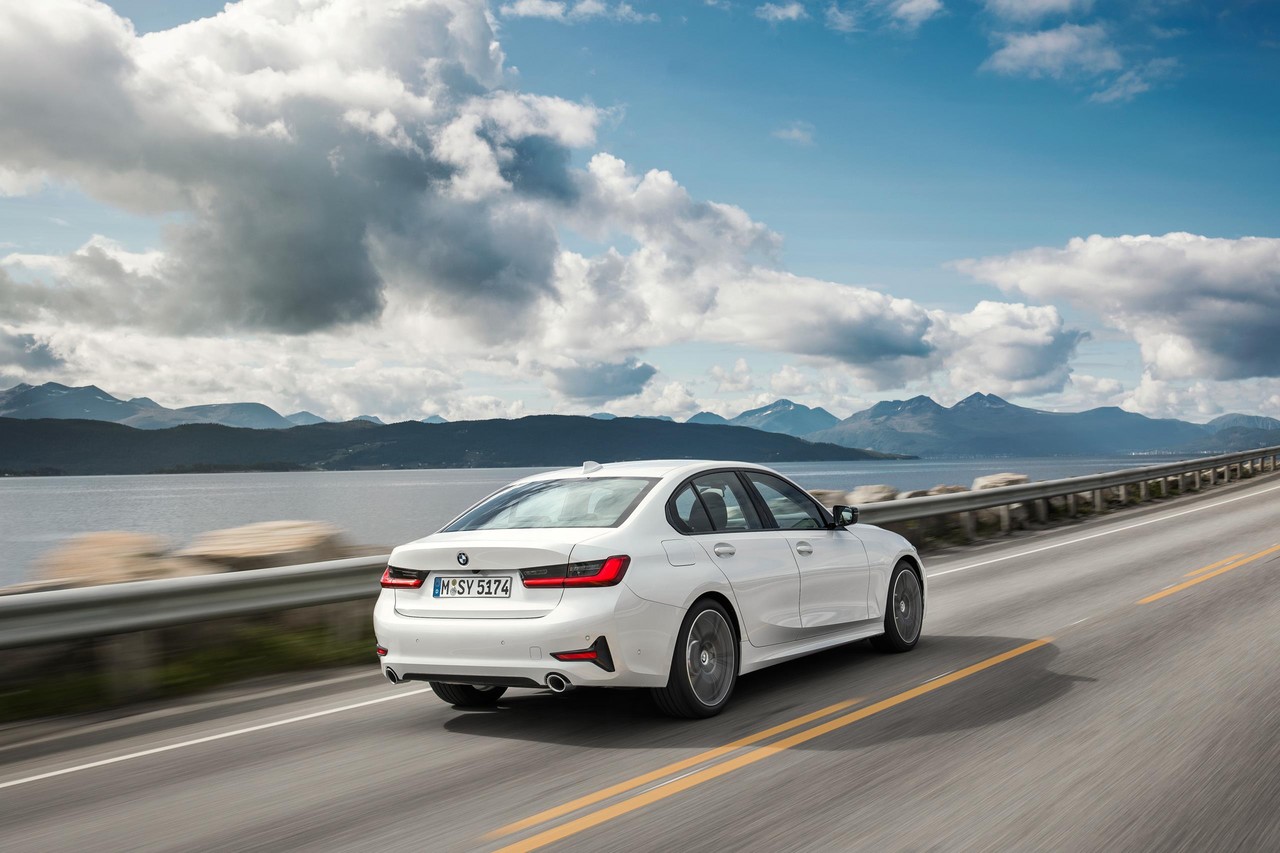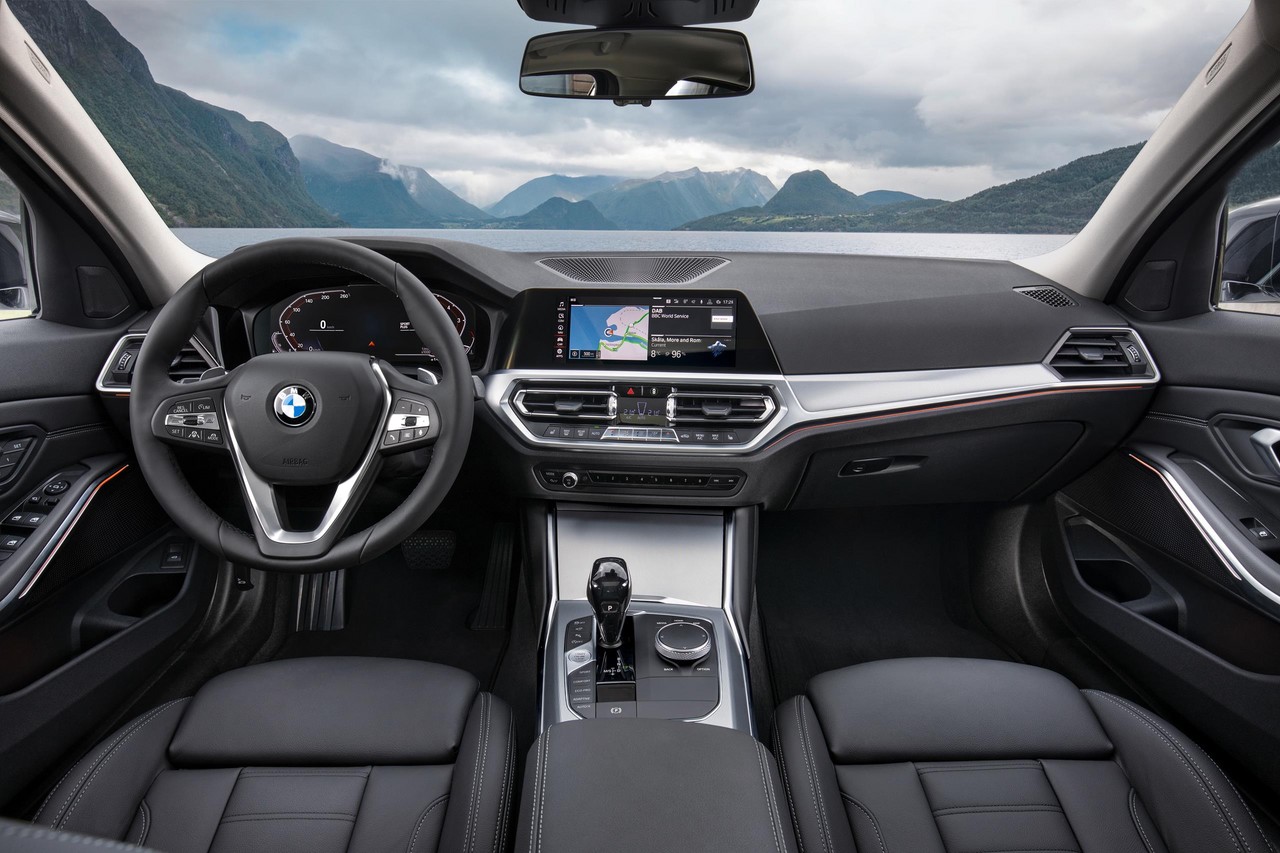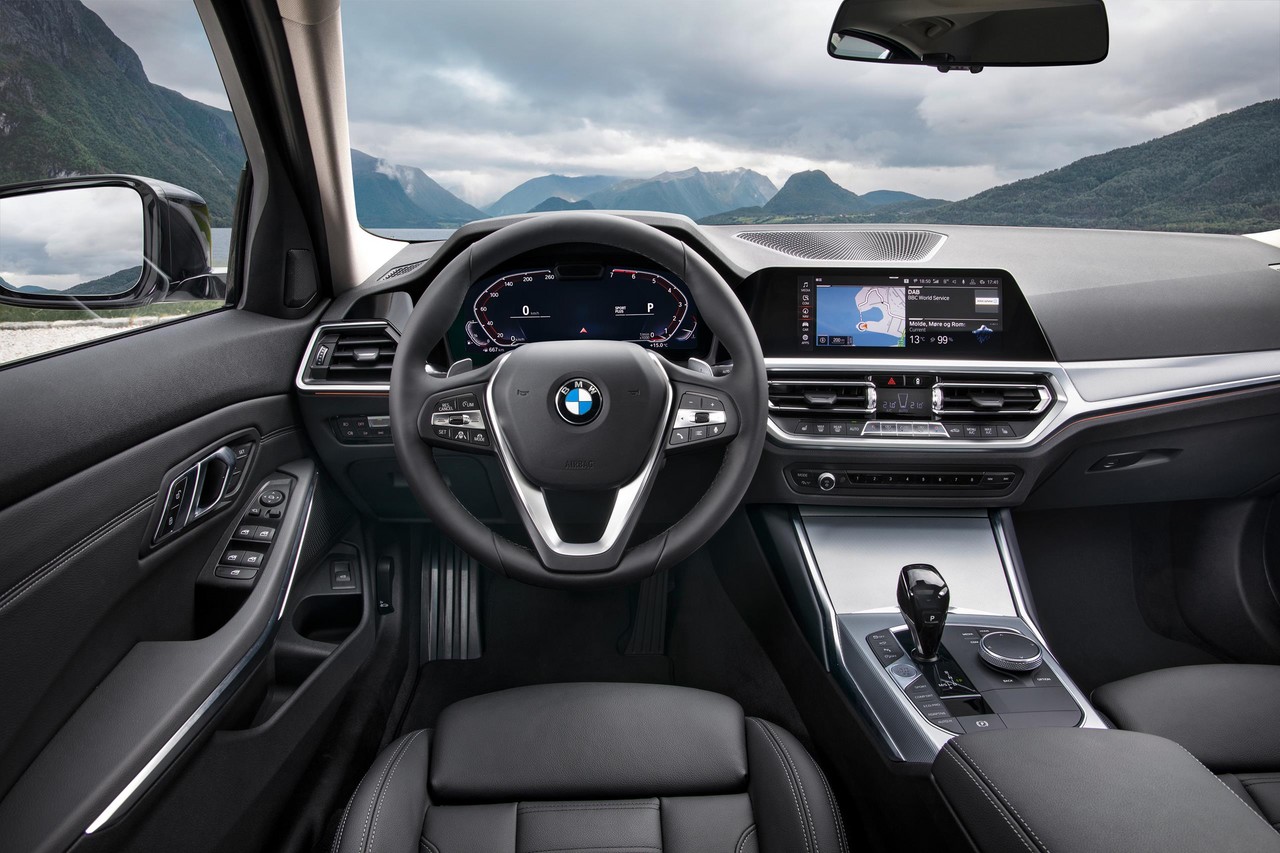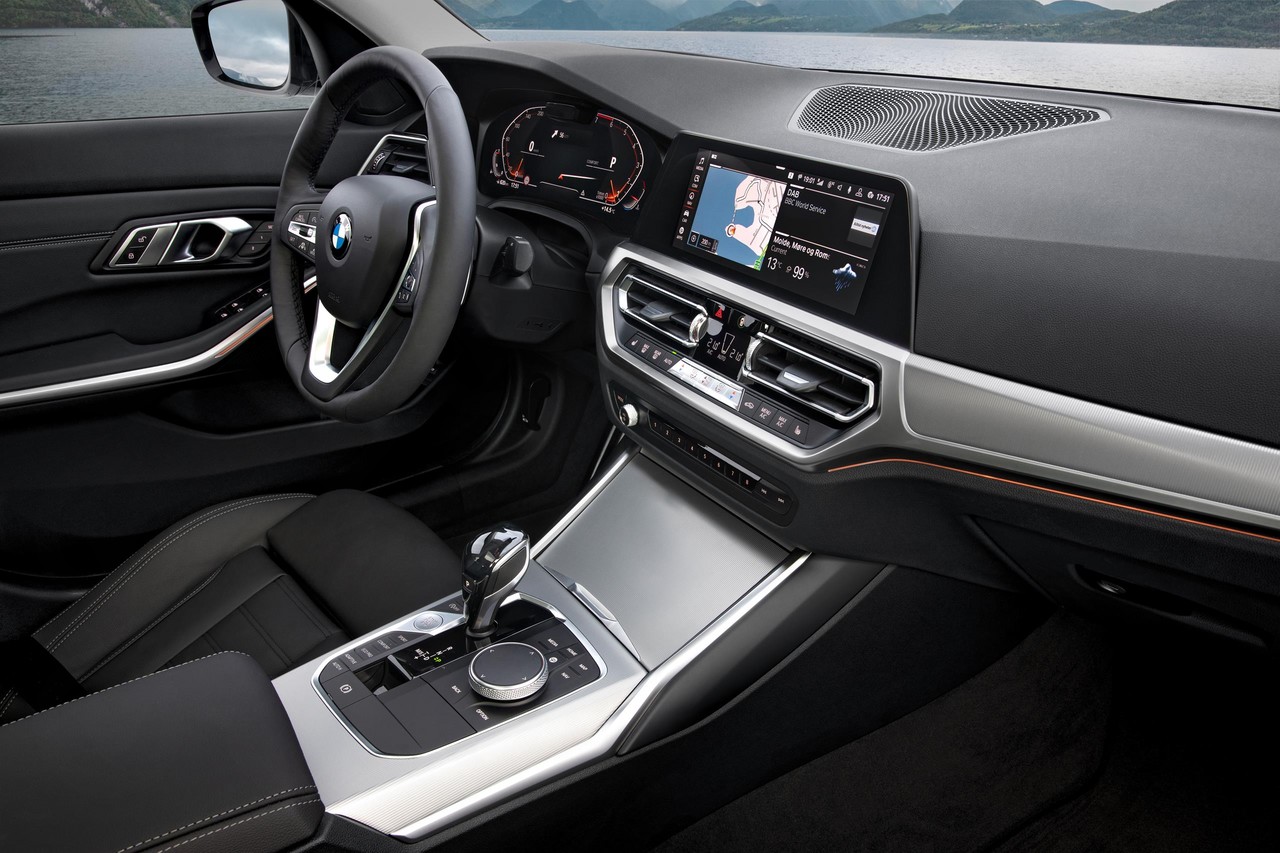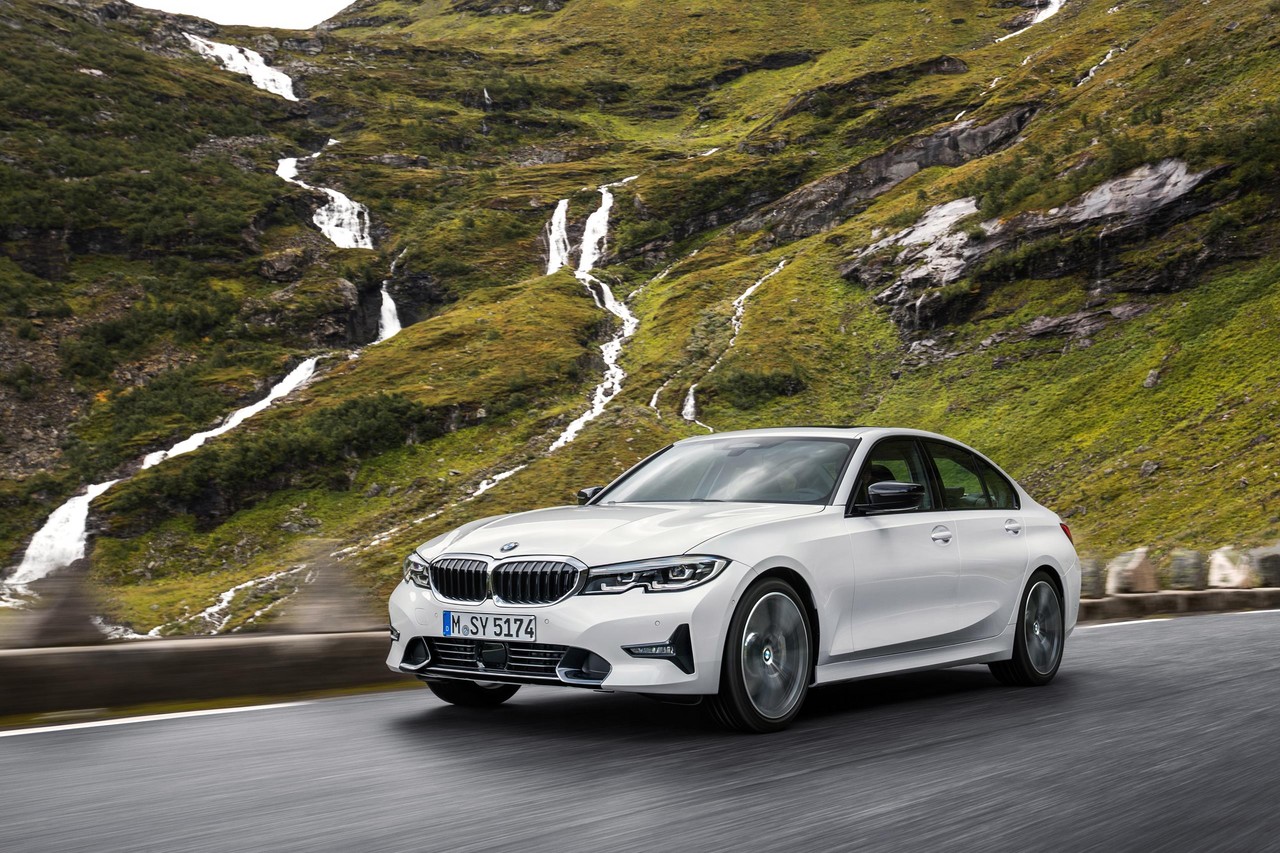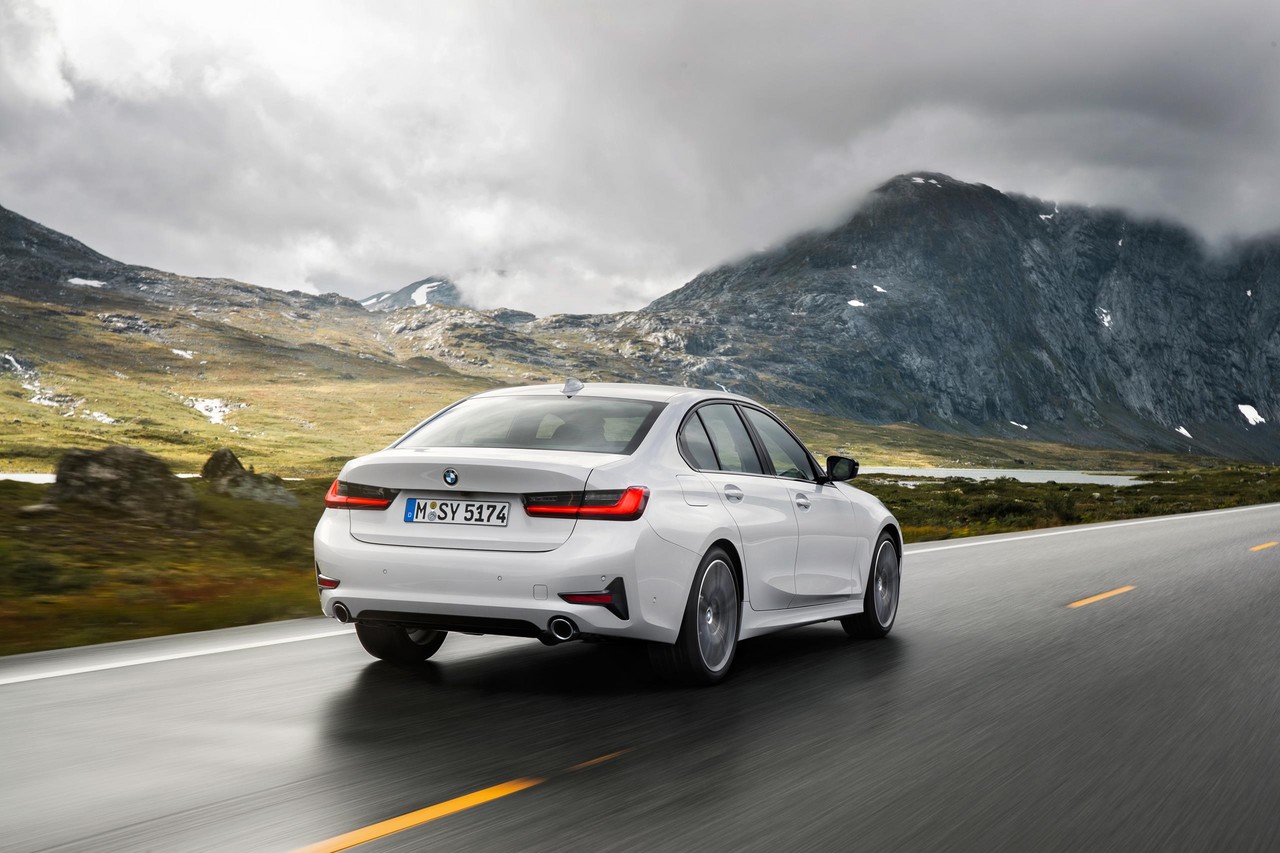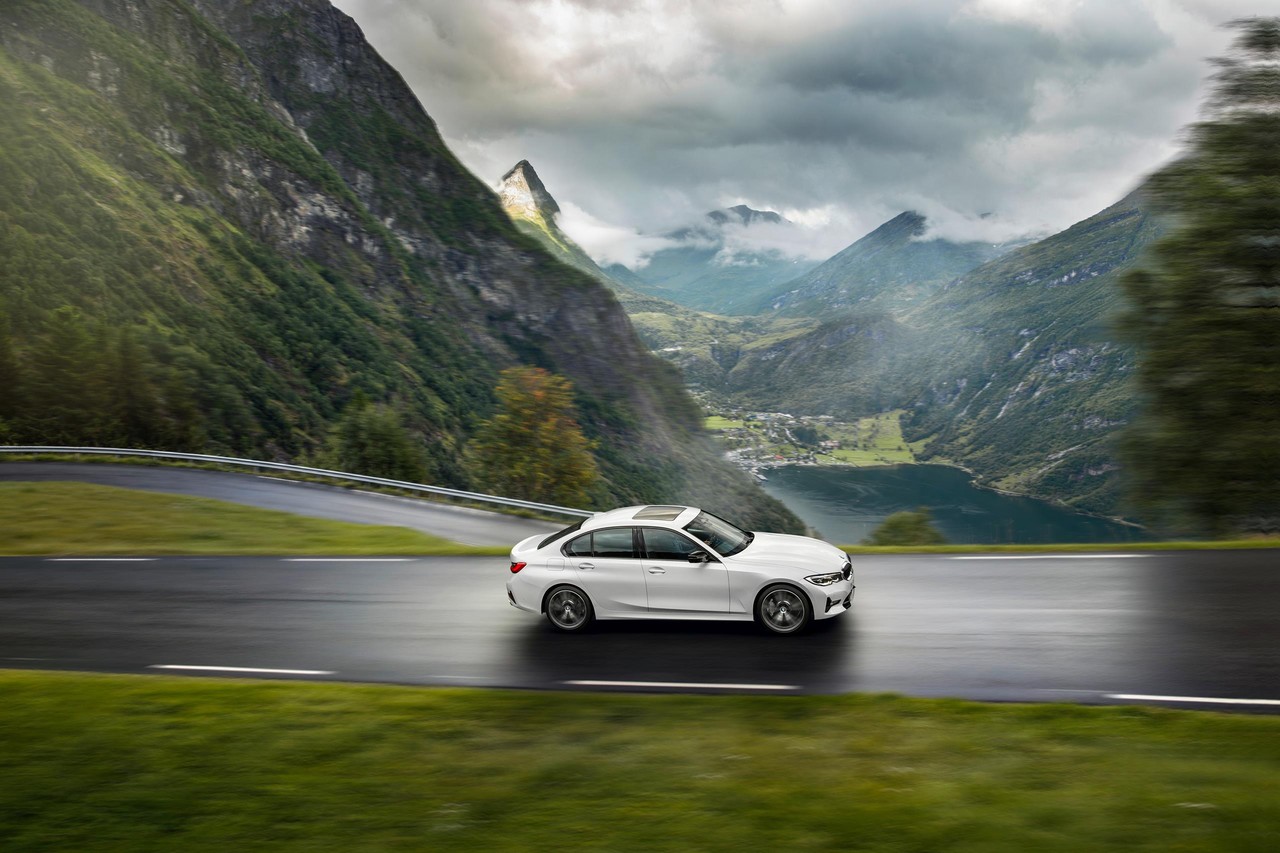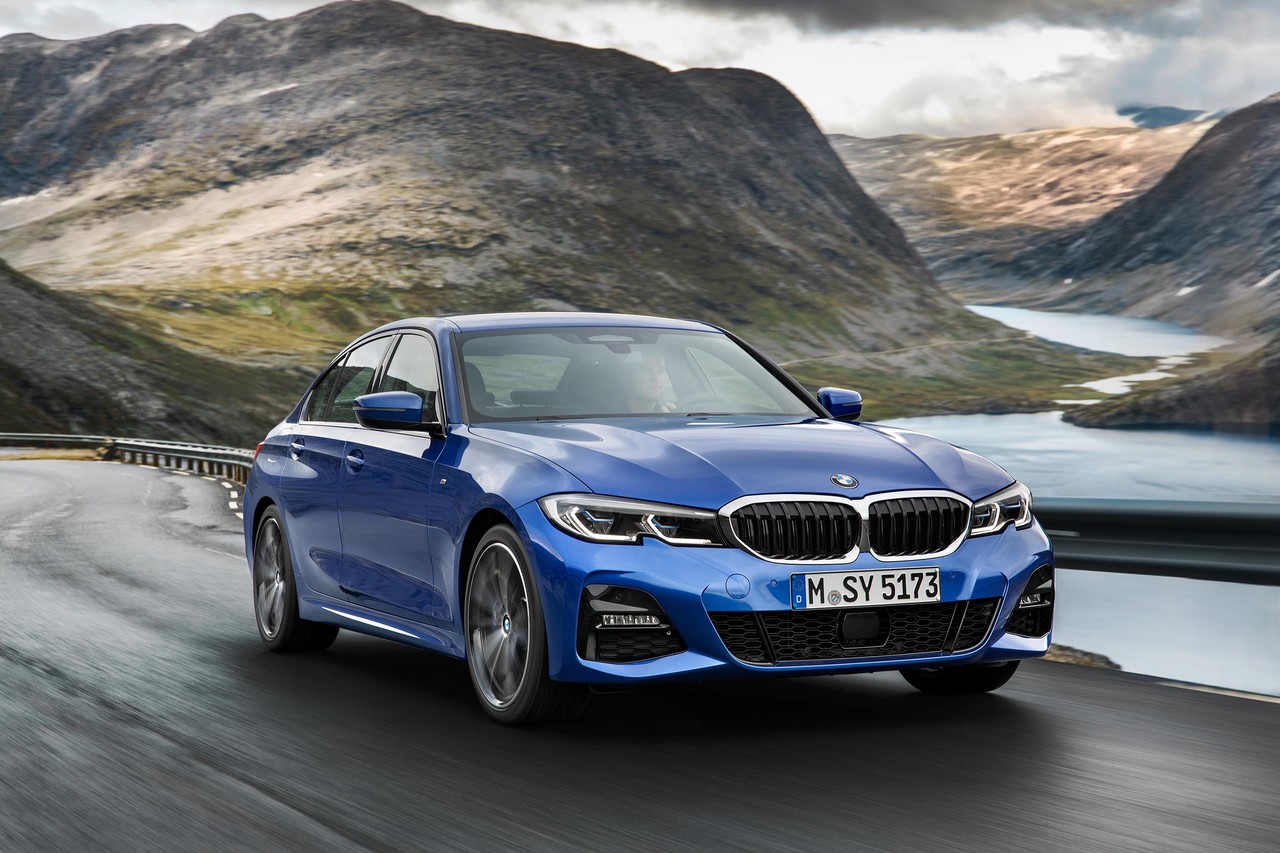
- Responsive turbocharged petrol engines
- Refined eight-speed automatic transmissions have coasting function
- Quieter interior due to double glazed windscreen and extra A-pillar insulation
- Forget the 320d – it misses out on safety technologies that are standard on the 330i
- Ride quality? Damping forces are up 20 per cent over F30 3-Series
- Long bonnet reduces interior space and raked roofline compromises rear headroom
- Steering feel?
Overview
Released in Australia in March 2019, the BMW G20 3-Series was a compact executive sedan. For Australia, the BMW G20 3-Series range initially consisted of 320d and 330i models, with M340i xDrive models expected to follow later in 2019. Australian-delivered BMW G20 3-Series Sedans were manufactured in Rosslyn, South Africa.
Engines for the BMW G20 3-Series had an ‘Auto Start Stop’ function which enabled them to shut down when the vehicle was stationary in traffic to reduce fuel consumption. Furthermore, movement of vehicles ahead was registered to determine the ideal moment for the Auto Start Stop function to operate. For models with the eight-speed automatic transmission (BMW’s ‘Steptronic’), a coasting function could operate at speeds between 15 km/h and 160 km/h to disengage the engine from the drivetrain to prevent engine braking. The coasting function used data from the navigation system, front camera and sensors for optional navigation system to prevent ‘inefficient engine shutdown’.
| Model | Engine | Trans. | Peak power | Peak torque |
|---|---|---|---|---|
| 330i | 1998 cc B48 turbo petrol I4 | 8sp auto | 190 kW at 5000-6500 rpm | 400 Nm at 1550-4400 rpm |
| M340i xDrive | 2998 cc B58 turbo petrol I6 | 8sp auto | 275 kW at 5500 rpm | 500 Nm at 1500-4500 rpm |
| 320d | 1995 cc B47 biturbo diesel I4 | 8sp auto | 140 kW at 4000 rpm | 400 Nm at 1750-2500 rpm |
Body and dimensions
The BMW G20 3-Series was underpinned by BMW’s Cluster Architecture (CLAR) platform. Compared to the BMW F30 3-Series Sedan , the G20 3-Series Sedan was 76 mm longer (at 4709 mm), 16 mm wider (1827 mm), 1 mm taller (1442 mm) and had a 41 mm longer wheelbase (2851 mm). Beyond this,
- The G20 3-Series achieved a 25 per cent increase in overall body rigidity and up to 50 per cent for certain areas;
- The BMW G20 3-Series was up to 55 kg lighter than its predecessor and its body-in-white was around 20 kg lighter. Mass reductions were achieved through the use of aluminium for the bonnet, front side panels, front spring struts and engine sub-frame. The BMW G20 330i, for example, had an unladen weight of 1470 kg (excluding driver);
- To reduce interior noise, the BMW G20 3-Series had a double-glazed (‘acoustic’) windscreen and additional insulation for the A-pillars; and,
- Luggage capacity was unchanged at 480 litres.
The G20 3-Series had underbody panelling to improve its aerodynamics; the 320d, for example, has a drag co-efficient of 0.23 Cd.
Suspension
The BMW G20 3-Series had a double-joint spring-strut front axle (i.e. double wishbone front suspension) with hydraulically damped torque strut bearings and a five-link rear axle. To reduce unsprung mass, the G20 3-Series had:
- Aluminium front spring struts;
- Aluminium swivel bearings and control arms for the front axle;
- Aluminium wheel mounts; and,
- New wheel bearings for the rear axle.
Compared to BMW F30 3-Series , the suspension for the G20 3-Series had significantly increased front wheel camber and a 20 per cent increase in suspension spring rates.
The BMW G20 3-Series introduced ‘lift-related dampers’ which provided additional hydraulic damping at the front axle and a compression limiting system at the rear. At the front axle, there was an additional damping element within the inner sleeve of the shock absorber which activate when significant loads were encountered. According to BMW, the life-related dampers reduced body movement when evening out vibrations. Lift-related damping was included in the standard suspension and optional M Sport suspension.
Available as an option, the ‘M Sport’ suspension had unique kinematics and elastokinematics that were tuned for dynamic driving. Other changes included:
- More rigid bearings;
- Additional body struts;
- Firmer springs and anti-roll bars;
- Increased negative camber;
- Damping forces that were around 20 per cent greater during fast compression and rebound; and,
- A 10 mm lower ride height.
Fitted as standard for Australian-delivered BMW 330i models, the ‘Adaptive M’ suspension combined the M Sport suspension with electronically controlled dampers that continuously adjusted damping force at each wheel via adjustable valves.
Steering
The BMW G20 3-Series had rack-and-pinion steering with electric, speed-sensitive power assistance; the G20 3-Series had a turning circle of 11.4 metres. The standard steering ratio for the G20 3-Series was 14.1:1, though variable ratio steering was included with the M Sport suspension and Adaptive M Sport suspension options.
Safety equipment
Standard safety equipment for the BMW G20 3-Series Sedan included dual front airbags, front seat-mounted side airbags, full-length curtain airbags, ABS, electronic brakeforce distribution, brake assist, electronic stability control, traction control and front seatbelts with pre-tensioners and load limiters.
As standard, the G20 3-Series was fitted with –
- BMW’s ‘Active Protection’: if a collision risk was detected from preceding vehicles or stationary objects, Active Protection would activate the front seatbelt tensioners and close the windows (and sunroof, where fitted). After a collision, Active Protection automatically applied the brakes to bring the vehicle to rest, thereby reducing the likelihood and potential severity of a secondary collision; and,
- An ‘active bonnet’ which had pyrotechnic actuators in the bonnet hinges. In the event of a pedestrian collision, the actuators would deploy and locks would keep the bonnet in a raised position to provide additional deformation space between the bonnet and hard structures beneath it.
As standard, Australian-delivered G20 3-Series vehicles were equipped with BMW’s ‘Driving Assistant’ which consisted of –
- Forward Collision Warning and Pedestrian Warning with City Braking: operating at speeds from 10 km/h to 60 km/h for pedestrian and cyclist detection and up to 80 km/h for vehicle detection, the approach control warning system would initially warn the driver if there was a risk of a frontal collision. In its second stage, the braking system was prepared for faster response and, if the driver failed to react, autonomous emergency braking (AEB) would be initiated to reduce vehicle speed;
- Lane Departure Warning: active at speeds from 70 km/h to 210 km/h, the driver would be alerted by steering wheel vibrations if the vehicle deviated from its lane without prior activation of the indicators;
- Lane Change Warning: active at speeds above 10 km/h, Lane Change Warning monitored the zones to each side of the vehicle. If the driver activated the indicators to change lanes, the system would check these zones and – if occupied – warn the driver via steering wheel vibrations and flashing a symbol in the respective door mirror;
- Crossing-traffic warning rear: when reversing out of a parking space, ‘Crossing-traffic warning rear’ would warn the driver of approaching traffic that may intersect the driver’s path. If a collision was anticipated, the brakes would be applied to reduce vehicle speed;
- Rear Collision warning: if a rear-end collision was anticipated, following traffic would be warned by double frequency flashing of the hazard lights; and,
- Speed Limit Info: incorporated speed restrictions into the driver-selectable Speed Limiter function or Active Cruise Control.
The BMW G20 330i was further equipped with BMW’s ‘Driving Assistant Professional’ which added –
- Active Cruise Control with Stop&Go: at speeds from 30 km/h to 210 km/h, Active Cruise Control could maintain a speed-dependent distance from the vehicle ahead. With the Stop&Go function, the brakes could be applied to bring the G20 3-Series to rest; once the traffic ahead began to accelerate, the 3-Series would automatically accelerates if the vehicle had been stationary for a period up to 30 seconds;
- Steering and lane control assistant: operating at speeds up to 210 km/h, the steering and lane control assistant provided ‘comfort-enhancing steering interventions’ to keep the vehicle in its current lane (even where road markings are unclear). In stop-start traffic, the system also used the preceding vehicle as a reference point;
- Emergency Stop Assistant: if the driver was suddenly incapacitated, pulling the electric parking brake switch would – depending on the driving situation and surrounds – bring the vehicle to a standstill 1) in its current lane, 2) at the edge of the road or 3) on the hard shoulder. Any necessary lane-change manoeuvres could be performed automatically when travelling at speeds between 70 and 100 km/h. When Emergency Stop Assistant was activated, the hazard warning lights would flash and the Intelligent Emergency Call function would automatically notify BMW’s call centre so that emergency services could be alerted;
- Lane Keeping Assistant: helped the driver pre-empt hazards by automatically applying corrective steering in three types of situation: 1) if the system detected that the vehicle was about to leave the road, 2) if the driver was about to change lanes and had not seen a vehicle in the next lane or 3) if danger was detected due to an approaching vehicle. Furthermore, holding the direction indicator could initiate a lane change;
- Side Collision Warning (also known as ‘Active Side Collision Protection’): operating at speeds between 30 km/h and 210 km/h, Side Collision Warning alerted drivers via a visual signal or steering wheel vibration if another vehicle was ‘encroaching’ from the side. If the system detected sufficient room on the other side of the vehicle, it would correctively steer the vehicle in this direction to avoid the danger. The corrective steering assistance, however, could be over-ridden by the driver at any time;
- Crossing traffic warning front: used radar sensors to check for approaching traffic at junctions with poor or impeded visibility. If a collision was anticipated, the brakes would be applied to reduce vehicle speed;
- Evasion aid: operating at speeds up to 160 km/h, the evasion aid helped avoid collisions with vehicles or pedestrians that suddenly appeared in the driver’s path by providing steering inputs that assisted the driver to direct the vehicle into a clear adjacent lane;
- Crossroads warning: provided visual and audible warnings in priority situations (i.e. where vehicles on another road had right of way) and at stop signs. At speeds up to 84 km/h, the steering wheel would also vibrate to alert the driver; and,
- Automatic Speed Limit Assistant: combined the speed limiter and road sign recognition functions and, when a speed limit change was detected, the Assistant would recommend to adapt the limiter to the new value by using the cruise control/speed limiter rocker switch on the steering wheel.
Features: BMW G20 320d
Australian-delivered BMW G20 3-Series Sedans were equipped with ‘BMW Live Cockpit Professional’ which consists of a 10.25-inch central touchscreen, a 12.3-inch high-resolution instrument display, a hard-drive based multimedia system with a 20 GB hard drive, a digital radio tuner (DAB+), an adaptive navigation system, Bluetooth mobile phone connectivity, Apple CarPlay, wireless mobile phone charging and USB inputs (Type A and Type C). BMW’s Operating System 7.0 also included the ‘BMW Intelligent Personal Assistant’ which responded to the prompt ‘Hey BMW’ and enabled the driver to operate functions by voice command.
Beyond this, standard features for the BMW G20 320d included 18-inch ‘M’ alloy wheels, a ten speaker ‘HiFi’ sound system with a 205 watt digital amplifier, combination Alcantara and Sensatec upholstery, power adjustable front sports seats with memory settings, three-zone climate control air conditioning, adaptive LED headlights with BMW’s ‘High Beam Assistant’, LED fog lights, a rear view camera, front and rear parking sensors, rain-sensing wipers, 40:20:40 split-fold rear seats with through-loading, a leather steering wheel (with multi-function buttons, thumb rests and electroplated applications), remote central locking, power adjustable and heated door mirrors with folding function, power windows, a height and reach adjustable steering wheel, push-button start, an auto-dimming rear-view mirror and driver’s side door mirror, floor mats, a trip computer, an alarm and immobiliser.
The BMW G20 320d was also equipped with –
- A head-up Display (HUD) which projected driving-related information directly into the driver’s field of vision on the windscreen. The information included the car’s speed, speed limits, overtaking restrictions, Check Control messages, status indicators, warnings from the assistance systems, detailed route guidance and turn instructions, and telephone and entertainment lists;
- BMW’s ‘Parking Assistant’ which used ultrasonic sensors to detect parallel or perpendicular parking spaces and manoeuvre the G20 3-Series into them. The Parking Assistant could also exit parallel parking spaces; and,
- BMW’s ‘Reversing Assistant’ which stored the steering movements for any section the car had driven forward along at speeds under 36 km/h. The system was then able to reverse the vehicle for distances of up to 50 metres by steering along exactly the same path as it took when moving forward, while the driver controlled vehicle speed. For the Reversing Assistant, maximum vehicle speed was limited to 9 km/h.
Features: BMW G20 330i
Compared to the BMW 320d, the BMW 330i was further equipped with 19-inch ‘M’ double-spoke alloy wheels, ‘Vernasca’ leather upholstery and BMW’s ‘Comfort Access’ (i.e. proximity key). The BMW 330i also featured BMW’s ‘Parking Assistant Plus’ which included Top View, Panorama and 3D View functions to create a 360-degree image of the vehicle and its surroundings which was displayed in the Control Display. Furthermore, the Remote 3D View feature could be used to access a three-dimensional live image of the vehicle and surroundings on a smartphone.
M Sport, M Sport Plus and Luxury Line
For Australian-delivered vehicles, BMW’s ‘M Sport’ package was included as standard. The M Sport package could be identified by its large air intakes and unique side skirts, high-gloss black kidney grille bars and air intake trim, black window frames, and ‘Dark Shadow’ rear diffuser. Inside, the M Sport package featured sports seats with M-specific upholstery, an M leather steering wheel, anthracite-coloured BMW Individual headliner and ‘Aluminium Tetragon’ interior trim strips.
As a no-cost option, however, G20 3-Series vehicles could be specified with BMW’s ‘Luxury Line’ trim which consisted of a chrome kidney grille, front air intakes and rear apron. Inside, the Luxury Line had Vernasca leather trim, Sensatec (synthetic leather) trim for the instrument panel and doors, and high-gloss Ash fine wood interior trim strips.
As an extra-cost option, the BMW G20 3-Series could be specified with an ‘M Sport Plus’ package which consisted of M Sport seatbelts (with M tricolour weave), an M rear spoiler, ‘M Sport’ brakes (for the G20 320d since they were already standard for the G20 330i) and an ‘M Sport’ differential (G20 330i only). The electronically controlled, fully variable ‘M Sport’ differential uses the DSC system to limit rotational speed differences between the inside and outside rear wheels when cornering, thereby reducing understeer. The locking effect produced by an electric motor allows up to 1500 Nm to be redirected from the faster-turning wheel to the slower-turning wheel to counter understeer.
Options: BMW G20 3-Series Sedan
Options for the BMW G20 3-Series included –
- A Harman Kardon surround system which had 16 speakers and a seven-channel digital amplifier with an output of 464 watts; and,
- Adaptive LED headlights with BMW Laserlight for a range of around 530 metres. These headlights could be be identified by their hexagonal daytime driving light rings and blue, L-shaped elements in the inner and outer light sources.
Related links
Specifications
